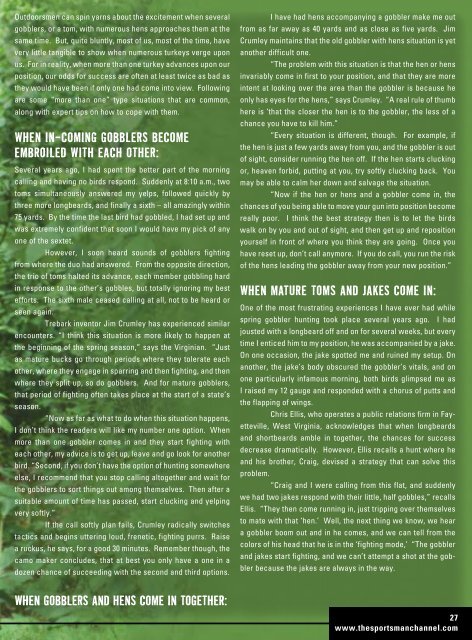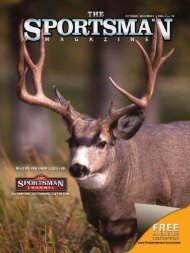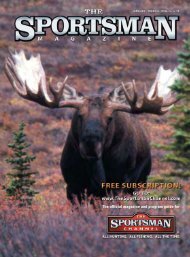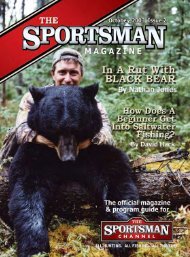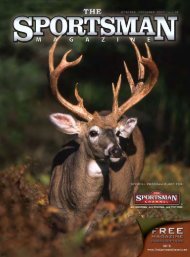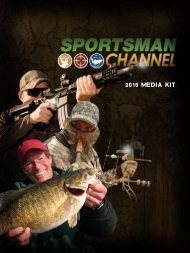Outfitting you for seasons of success. - The Sportsman Channel
Outfitting you for seasons of success. - The Sportsman Channel
Outfitting you for seasons of success. - The Sportsman Channel
- No tags were found...
Create successful ePaper yourself
Turn your PDF publications into a flip-book with our unique Google optimized e-Paper software.
Outdoorsmen can spin yarns about the excitement when severalgobblers, or a tom, with numerous hens approaches them at thesame time. But, quite bluntly, most <strong>of</strong> us, most <strong>of</strong> the time, havevery little tangible to show when numerous turkeys verge uponus. For in reality, when more than one turkey advances upon ourposition, our odds <strong>for</strong> <strong>success</strong> are <strong>of</strong>ten at least twice as bad asthey would have been if only one had come into view. Followingare some “more than one” type situations that are common,along with expert tips on how to cope with them.When In-Coming Gobblers BecomeEmbroiled with Each Other:Several years ago, I had spent the better part <strong>of</strong> the morningcalling and having no birds respond. Suddenly at 8:10 a.m., twotoms simultaneously answered my yelps, followed quickly bythree more longbeards, and finally a sixth – all amazingly within75 yards. By the time the last bird had gobbled, I had set up andwas extremely confident that soon I would have my pick <strong>of</strong> anyone <strong>of</strong> the sextet.However, I soon heard sounds <strong>of</strong> gobblers fightingfrom where the duo had answered. From the opposite direction,the trio <strong>of</strong> toms halted its advance, each member gobbling hardin response to the other’s gobbles, but totally ignoring my bestef<strong>for</strong>ts. <strong>The</strong> sixth male ceased calling at all, not to be heard orseen again.Trebark inventor Jim Crumley has experienced similarencounters. “I think this situation is more likely to happen atthe beginning <strong>of</strong> the spring season,” says the Virginian. “Justas mature bucks go through periods where they tolerate eachother, where they engage in sparring and then fighting, and thenwhere they split up, so do gobblers. And <strong>for</strong> mature gobblers,that period <strong>of</strong> fighting <strong>of</strong>ten takes place at the start <strong>of</strong> a state’sseason.“Now as far as what to do when this situation happens,I don’t think the readers will like my number one option. Whenmore than one gobbler comes in and they start fighting witheach other, my advice is to get up, leave and go look <strong>for</strong> anotherbird. “Second, if <strong>you</strong> don’t have the option <strong>of</strong> hunting somewhereelse, I recommend that <strong>you</strong> stop calling altogether and wait <strong>for</strong>the gobblers to sort things out among themselves. <strong>The</strong>n after asuitable amount <strong>of</strong> time has passed, start clucking and yelpingvery s<strong>of</strong>tly.”If the call s<strong>of</strong>tly plan fails, Crumley radically switchestactics and begins uttering loud, frenetic, fighting purrs. Raisea ruckus, he says, <strong>for</strong> a good 30 minutes. Remember though, thecamo maker concludes, that at best <strong>you</strong> only have a one in adozen chance <strong>of</strong> succeeding with the second and third options.I have had hens accompanying a gobbler make me outfrom as far away as 40 yards and as close as five yards. JimCrumley maintains that the old gobbler with hens situation is yetanother difficult one.“<strong>The</strong> problem with this situation is that the hen or hensinvariably come in first to <strong>you</strong>r position, and that they are moreintent at looking over the area than the gobbler is because heonly has eyes <strong>for</strong> the hens,” says Crumley. “A real rule <strong>of</strong> thumbhere is ‘that the closer the hen is to the gobbler, the less <strong>of</strong> achance <strong>you</strong> have to kill him.”“Every situation is different, though. For example, ifthe hen is just a few yards away from <strong>you</strong>, and the gobbler is out<strong>of</strong> sight, consider running the hen <strong>of</strong>f. If the hen starts cluckingor, heaven <strong>for</strong>bid, putting at <strong>you</strong>, try s<strong>of</strong>tly clucking back. Youmay be able to calm her down and salvage the situation.“Now if the hen or hens and a gobbler come in, thechances <strong>of</strong> <strong>you</strong> being able to move <strong>you</strong>r gun into position becomereally poor. I think the best strategy then is to let the birdswalk on by <strong>you</strong> and out <strong>of</strong> sight, and then get up and reposition<strong>you</strong>rself in front <strong>of</strong> where <strong>you</strong> think they are going. Once <strong>you</strong>have reset up, don’t call anymore. If <strong>you</strong> do call, <strong>you</strong> run the risk<strong>of</strong> the hens leading the gobbler away from <strong>you</strong>r new position.”When Mature Toms and Jakes Come In:One <strong>of</strong> the most frustrating experiences I have ever had whilespring gobbler hunting took place several years ago. I hadjousted with a longbeard <strong>of</strong>f and on <strong>for</strong> several weeks, but everytime I enticed him to my position, he was accompanied by a jake.On one occasion, the jake spotted me and ruined my setup. Onanother, the jake’s body obscured the gobbler’s vitals, and onone particularly infamous morning, both birds glimpsed me asI raised my 12 gauge and responded with a chorus <strong>of</strong> putts andthe flapping <strong>of</strong> wings.Chris Ellis, who operates a public relations firm in Fayetteville,West Virginia, acknowledges that when longbeardsand shortbeards amble in together, the chances <strong>for</strong> <strong>success</strong>decrease dramatically. However, Ellis recalls a hunt where heand his brother, Craig, devised a strategy that can solve thisproblem.“Craig and I were calling from this flat, and suddenlywe had two jakes respond with their little, half gobbles,” recallsEllis. “<strong>The</strong>y then come running in, just tripping over themselvesto mate with that ‘hen.’ Well, the next thing we know, we heara gobbler boom out and in he comes, and we can tell from thecolors <strong>of</strong> his head that he is in the ‘fighting mode,’ “<strong>The</strong> gobblerand jakes start fighting, and we can’t attempt a shot at the gobblerbecause the jakes are always in the way.When Gobblers and Hens Come in Together:27www.thesportsmanchannel.com


